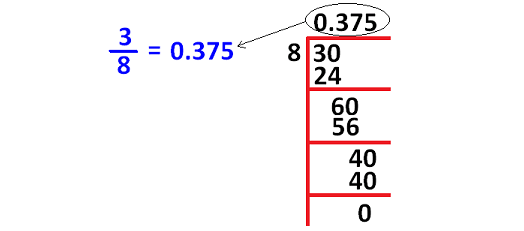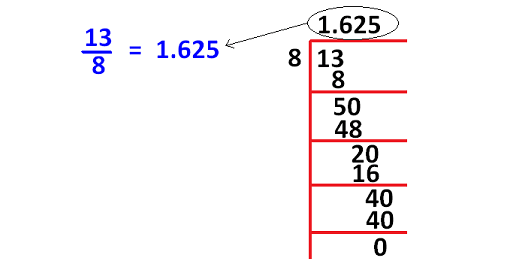CONVERT BETWEEN DECIMALS AND FRACTIONS
Subscribe to our ▶️ YouTube channel 🔴 for the latest videos, updates, and tips.
Converting Decimals to Fractions
Step 1 :
To convert a decimal to a fraction, multiply and divide the decimal by 10 or 100 or 1000 etc.,
Step 2 :
After having converted the decimal to fraction, do the possible simplification, if any.
Converting Fractions to Decimals
To convert a fraction to decimal, first check whether the denominator of the fraction is convertible to 10 or 100 using multiplication.
If it is convertible to 10 or 100 using multiplication, convert the fraction to decimal as explained below.


If it is not convertible to 10 or 100 using multiplication, we can convert the given fraction into decimal as explained below.


Solved Examples
Example 1 :
Convert the following decimal to fraction.
0.75
Solution :
In 0.75, because there are two digits after the decimal point, multiply and divide 0.75 by 100 to get rid of the decimal point.
0.75 = (0.75 ⋅ 100) / 100
0.75 = 75 / 100
In the fraction 75/100, the greatest common divisor of both numerator and denominator is 25.
So, divide both numerator and denominator by 25.
0.75 = (75 ÷ 25) / (100 ÷ 25)
0.75 = 3/4
Example 2 :
Convert the following decimal to fraction.
2.4
Solution :
In 2.4, because there is only one digit after the decimal point, multiply and divide 2.4 by 10 to get rid of the decimal point.
2.4 = (2.4 ⋅ 10) / 10
2.4 = 24 / 10
In the fraction 24/10, the greatest common divisor of both numerator and denominator is 2.
So, divide both numerator and denominator by 2.
2.4 = (24 ÷ 2) / (10 ÷ 2)
0.24 = 12/5
Example 3 :
Convert the following decimal to fraction.
0.55
Solution :
In 0.55, because there are two digits after the decimal point, multiply and divide 0.55 by 100 to get rid of the decimal point.
0.55 = (0.55 ⋅ 100) / 100
0.55 = 55 / 100
In the fraction 55/100, the greatest common divisor of both numerator and denominator is 5.
So, divide both numerator and denominator by 5.
0.55 = (55 ÷ 5) / (100 ÷ 5)
0.55 = 11/20
Example 4 :
Convert the following fraction to decimal.
3/20
Solution :
In the given fraction, the denominator is 20 which is convertible to 100 using multiplication by 5.
So, we have
3/20 = (3 ⋅ 5) / (20 ⋅ 5)
3/20 = 15/100
3 / 20 = 0.15
Example 5 :
Convert the following fraction to decimal.
45/8
Solution :
Here, the denominator of the given fraction is 8 which can not be converted into 10 or 100 using multiplication.
So the given fraction can be converted into decimal using long division.
So, we have
45/8 = 5.625
Example 6 :
Find the largest fraction among the following.
1/2, 3/4, 5/6, 6/11, 2/3, 8/9, 6/7
a) 1/2 b) 8/9 c) 3/4 d) 6/7
Solution :
Let us try to convert each fraction as decimal.
1/2 = 0.5
3/4 x (25/25) = 75/100 ==> 0.75
5/6 = 0.83........
6/11 = 0.545.....
2/3 = 0.66......
8/9 = 0.888.....
6/7 = 0.857.......
Converting each fraction as decimal, we get the above decimals. Now comparing the decimals 0.88......... is greater. Then 8/9 is the greater fraction which is option B.
Example 7 :
Which of the following fractions has terminating decimal?
a) 10/33 b) 13/66 c) 10/56 d) 42/56
Solution :
The fraction which can be expressed in the form of
p/(2n x 5m)
is terminating decimal.
Option a :
10/33
Since the denominator is odd number, we cannot express it as product of 2. We cannot express it in the form above, so it is not terminating decimal.
Option b :
13/36
Since the denominator is even number, decomposing 36, we get
36 = 3 x 3 x 2 x 2
= 32 x 22
So, it is non terminating decimal.
Option c :
10/56
= 5/28
Since the denominator is even number, decomposing 28, we get
28 = 2 x 2 x 7
= 7 x 22
So, it is non terminating decimal.
Option d :
42/56
= 6/8
= 3/4
Since the denominator is even number, decomposing 4, we get
4 = 2 x 2
= 50 x 22
So, it is terminating decimal.
Example 8 :
Express 444/5% + 44/5% + 4/5% + 0.4/5% as a decimal number.
a) 0.8888 b) 0.9988 c) 0.8966 d) 0.9848
Solution :
= 444/5% + 44/5% + 4/5% + 0.4/5%
|
444/5 = 88.8 44/5 = 8.8 4/5 = 0.8 0.4/5 = 0.08 |
444/5% = 0.888 44/5% = 0.088 4/5% = 0.008 0.4/5% = 0.0008 |
444/5% + 44/5% + 4/5% + 0.4/5%
= 0.888 + 0.088 + 0.008 + 0.0008
= 0.9848
Example 9 :
If 2994 ÷ 145 = 20.65, then 29.94 ÷ 1.45 = ?
a) 20.65 b) 2.065 c) 206.5 d) 2065
Solution :
2994 ÷ 145 = 20.64
2994 ÷ 100 ==> 29.94
145 ÷ 100 ==> 1.45
Dividing the numerator and denominator by the same, we will not get anything different. So the answer is 20.65
Subscribe to our ▶️ YouTube channel 🔴 for the latest videos, updates, and tips.
Kindly mail your feedback to v4formath@gmail.com
We always appreciate your feedback.
©All rights reserved. onlinemath4all.com
Recent Articles
-
10 Hard SAT Math Questions (Part - 38)
Dec 08, 25 12:12 AM
10 Hard SAT Math Questions (Part - 38) -
SAT Math Practice
Dec 05, 25 04:04 AM
SAT Math Practice - Different Topics - Concept - Formulas - Example problems with step by step explanation -
10 Hard SAT Math Questions (Part - 37)
Dec 03, 25 07:02 AM
10 Hard SAT Math Questions (Part - 37)


